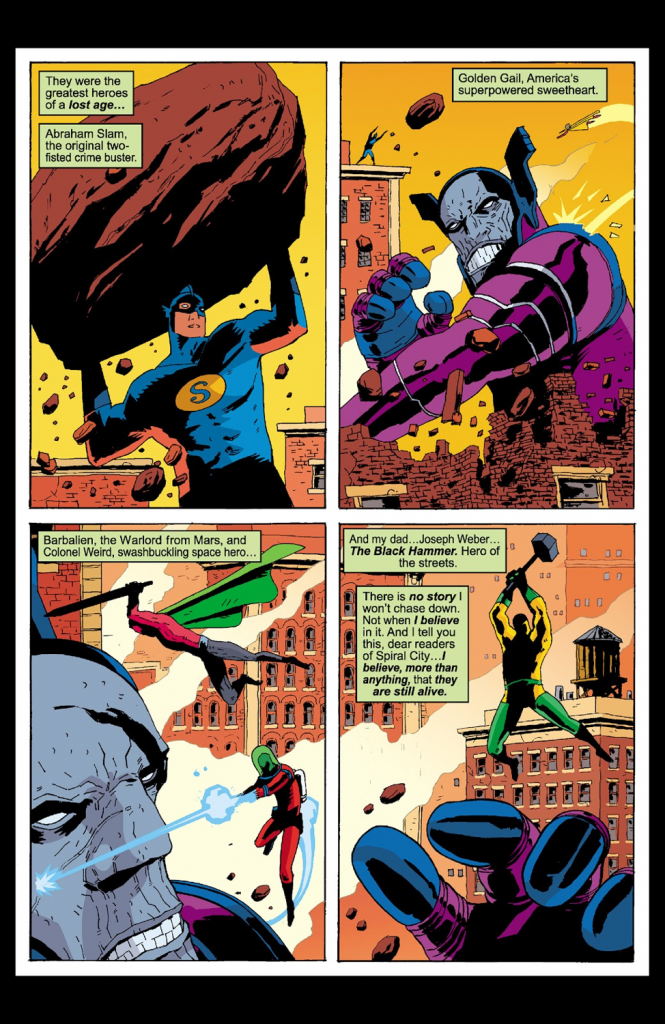Black Hammer doesn’t look much like a superhero comic. Dean Ormston’s remarkable art, which makes all the characters look like Modigliani subjects left out in the sun too long, is the farthest thing imaginable from the glossy splash pages of flawless demigods that characterize the genre today. Jeff Lemire’s scripts, too, seem far more interested in the quotidian and the personal than most plot-obsessed comics scribes. Yet this Eisner-winning series is unequivocally about superheroes—in fact, it accomplishes a feat that has long eluded the comics mainstream: nothing less than a psychologically credible reinvention of the superhero archetype.
When I make a claim like this, some among you may experience a sense of déjà vu. This profound development is what readers were promised in the eighties when writers like Alan Moore and Grant Morrison revolutionized the genre with dark, uncompromising stories that consciously rejected the flat characters and ludicrous conflicts of the Silver Age. Unfortunately, this movement’s early promise petered out as lesser writers confused ‘grim’ with ‘profound’ and plunged the medium into a Dark Age some believe it has not yet escaped from (though Black Hammer and recent books like it suggest otherwise).
Of course, there has been great work done in superhero comics since then, from the visionary fantasy of Jonathan Hickman to the free-flying satire of Matt Fraction to the abstract naturalism of Tom King. But none of it has ever quite managed to live up to that very specific ideal, arguably set by Moore’s seminal yet flawed Watchmen, of the superhero as a subject worthy of literary attention as serious as any other. The wisest creators don’t shoot for that at all, instead crafting stories that use the genre’s trademark out-there plots and broad characterization for maximum effect. That’s all perfectly good… but still that unfulfilled promise calls out.
Canadian Jeff Lemire (best known for the post-apocalyptic Sweet Tooth) had already produced plenty of stellar superhero stories, from Animal Man to Green Arrow, but they were firmly bound by the genre’s often arbitrary limitations. The sprawling and ambitious Black Hammer, which began to be serialized by Dark Horse in 2016 and remains ongoing, has already surpassed them all. What’s more, it’s emerged as one of the most incisive looks at the genre in a long time, a serious contender for achiever of that age-old dream if ever there was one.

Black Hammer tells the story of a group of heroes (all of them original, a refreshing decision in a landscape dominated by decades-old stalwarts) who seemingly ‘die’ defeating the monstrous Anti-God, a kind of Darkseid/Thanos/Galactus mishmash, only to be transported to a small town in an alternate dimension. Once it becomes obvious they can’t escape, they settle into a dysfunctional family dynamic. Each member is a twist on a familiar superhero archetype, deconstructed to foreground the human toll of living such a life.
For example, the ‘bratty daughter’ of the family, Golden Gail, is really a fifty-five-year-old woman who transforms into a child upon uttering her magic word. Her origin is a blatant riff on Captain Marvel (AKA Shazam!, whose name was changed for very complicated legal reasons), except inverted, so that this middle-aged woman is trapped in a young girl’s body, creating no end of angst. Forced to attend grade school to avoid suspicion, she acts up, smokes, and swears to relieve her frustration. Though her persistent complaining is frequently obnoxious, she never loses our sympathy—wouldn’t you feel the same way?
It’s the same for the others, like Barbalien, a Martian Manhunter-style extraterrestrial visitor forced to live among Earthlings, whose alienation is compounded by the homophobia he faces whenever he makes romantic advances, or Abraham Slam, a non-superpowered brawler like the original Atom who must contend with old age. All of them are recognizably superheroic figures, paying tribute to the all-time greats, yet they’re also distinctly fleshed out human beings. The deftness with which Lemire balances flashback scenes that show them fighting robots and monsters from space (written in a gleefully corny antiquated style) and the often grim and painful main storyline is downright miraculous.
There’s a lesson to be learned here. Unlike most attempts to make superheroes ‘realistic’, like DC’s gritty Earth One series, Black Hammer does not jettison the inherent silliness of the concept. Of course Abe Slam wears sky-blue tights and underwear on the outside; of course space hero Colonel Weird’s robot sidekick is named Talky-Walky. In every sequence, in every panel, Lemire’s obvious love for the medium in all its kitschy glory shines through.
But the series’ delicate balance also owes a great deal to the fiercely idiosyncratic pencils by Ormston (wonderfully completed by colorist Dave Stewart). By drawing all the usual scenes of costumed heroes facing towering robotic monstrosities in pitch-perfect detail but doing so in a style that always feels ever so slightly wrong, he pulls us completely into this strangely warped world.
Never for a moment does it feel like this could be ‘real life,’ but it doesn’t matter one bit. This peculiar reality is as convincing as any out there, and the people who inhabit it, be they time-displaced astronauts or green-skinned sorceresses, feel as real as anyone you might know. It calls to mind Lord David Cecil’s famous praise of Dickens: “It doesn’t matter that [his] world is not lifelike: it is alive”. Lemire and Ormston have accomplished a similar miracle with Black Hammer; dissecting an archetype now nearly a century old, they’ve fashioned an irresistible human drama that truly feels like nothing that’s come before.
Finally, those masked men feel like men, not just masks.
